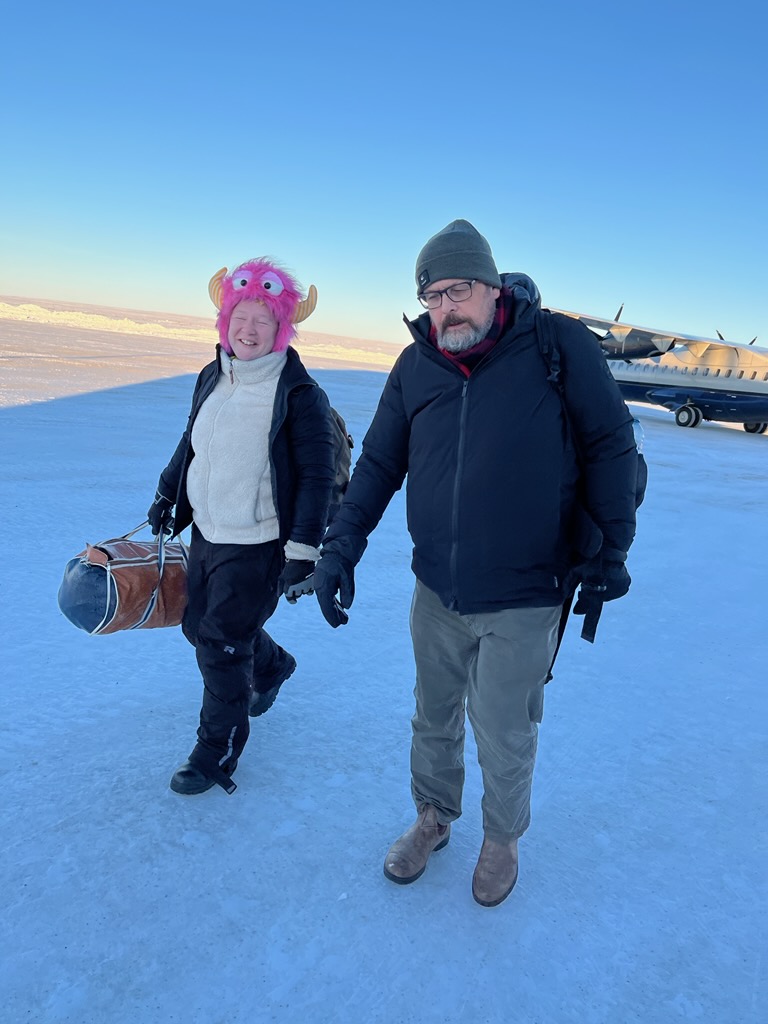Preparation Gjoa Haven Workshop: Difference between revisions
| (38 intermediate revisions by 3 users not shown) | |||
| Line 1: | Line 1: | ||
Now that I had a list of of solid and applicable guidelines to the workshop agenda, it was time to organize the workshop itself. | Now that I had a list of of solid and applicable guidelines to the workshop agenda, it was time to organize the workshop itself. | ||
<div class="next_choice"> | |||
<div class="next_choice"> | |||
You are '''"invited"''' to follow along with this preparation. | You are '''"invited"''' to follow along with this preparation. | ||
| Line 21: | Line 15: | ||
=3 day Workshop Gjoa Haven= | =3 day Workshop Gjoa Haven= | ||
At the evening of the November 21, it was time to start our Gathering. | |||
Attendees from the | Attendees from the South who would join for the gathering included the director and program manager of Genome Canada, a recently retired wildlife biologist who had run the BearWatch project in the Northwest Territories, a project manager for BearWatch, and three co-PI's of the project- two of them who had arrived three days prior to the gathering. | ||
<div class="next_choice"> | <div class="next_choice">'''"Keep going"''' for the final gathering per agenda point. Each session will be accompanied by guidelines, insights, motivations or research questions that underly the decision made for that segment. | ||
Or, | |||
'''"Detour"''' to skip straight to the Coral Harbour workshop. You will not return here.</div> | |||
<span class="detour to-cut-2 link" data-page-title="workshop Coral Harbour" data-section-id="1" data-encounter-type="detour">[[workshop Coral Harbour#Design Consultation Pre-Workshop & Workshop Coral Harbour|Detour to Cut 2:Coral Harbour Gathering]]</span> | <span class="detour to-cut-2 link" data-page-title="workshop Coral Harbour" data-section-id="1" data-encounter-type="detour">[[workshop Coral Harbour#Design Consultation Pre-Workshop & Workshop Coral Harbour|Detour to Cut 2:Coral Harbour Gathering]]</span> | ||
| Line 31: | Line 31: | ||
=Opening: Movie Screening and a Feast= | =Opening: Movie Screening and a Feast= | ||
Once we felt that people had settled in, and were comfortable, we opened the gathering with prayers and with some words from the Gjoa Haven HTA vice-chair, James Qitsualik, who had lead the project within the community. | |||
Once we felt that people had | |||
We then screened the three community co-created movies: Voices of Thunder, Pihhiq, and the throatsinging film with Kathy and Janet. | We then screened the three community co-created movies: Voices of Thunder, Pihhiq, and the throatsinging film with Kathy and Janet. | ||
[[File: | [[File:Community screening (photograph by de Wildt, 2022).jpg|thumb|Community screening (photograph by de Wildt, 2022)]] | ||
<div class="next_choice">After the movies, it | <div class="next_choice"> | ||
After the movies, it was time to eat. | |||
As was explicitly put forward during the pre-workshop, food is a way to all find ourselves on common ground – we are all human. It's a way for people to feel comfortable. "Within the community we have human-to-human differences as well".</div> | As was explicitly put forward during the pre-workshop, food is a way to all find ourselves on common ground – we are all human. It's a way for people to feel comfortable. "Within the community we have human-to-human differences as well".</div> | ||
| Line 47: | Line 44: | ||
=Polar Bear Landscape Presentation= | =Polar Bear Landscape Presentation= | ||
After the feast Marsha Brannigan presented on the governmental context within which the BearWatch project had played out. This presentation was put on the agenda | After the feast Marsha Brannigan, former wildlife biologist to the Northwest Territories presented on the governmental context within which the BearWatch project had played out. | ||
This presentation was put on the agenda to sketch a contextual backdrop for the next couple of days. Although the presentation took 90 minutes, Branigan clearly had lots of experience with presenting for community members, and often built in "empty" slides, for people to ask questions or comments. | |||
The opening evening ended with an invitation to come back the next days. We explained how the next three-day gathering was also part of the research project, and that people would be asked for their informed consent to be part of this research and to be photographed if they would come back over the next three days. We indicated our starting time, and explained the program for the next day: Science-presentations. | The opening evening ended with an invitation to come back the next days. We explained how the next three-day gathering was also part of the research project, and that people would be asked for their informed consent to be part of this research and to be photographed if they would come back over the next three days. We indicated our starting time, and explained the program for the next day: Science-presentations. | ||
| Line 53: | Line 52: | ||
=Day 1: Science-Presentations, Opening and Singing= | =Day 1: Science-Presentations, Opening and Singing= | ||
The previous evening, around the time of closing prayers, news had started to trickle into the room about a young women that had passed away that day due to an accident. People had been visibly upset the evening before, and still were so when they came back the next day. | |||
Elder Mary Aqilriaq, who was present to conduct the opening and closing prayers during this gathering requested to sing a song instead. | |||
We all got up from our chairs as Mary led us into song. It was an emotional moment of shared grief and many people started crying in the room. | We all got up from our chairs as Mary led us into song. It was an emotional moment of shared grief and many people started crying in the room. | ||
"Mary is gold. Even people here and there were telling me "I am so happy that Mary was here." Mary was perfect for us. It's really important that you pick the right person. There elders that are used to doing... being a master of ceremony, welcoming people, being the elder, you know. You used her. Her prayers are from ''the heart''. Singing with her voice, even it is broken down. Giving it all she got. That's priceless. If you could get that. Sometimes, words... You don't have to talk, ey? (Tuppittia Qitualik)" | ''"Mary is gold. Even people here and there were telling me "I am so happy that Mary was here."'' | ||
''"Mary was perfect for us. It's really important that you pick the right person. There elders that are used to doing... being a master of ceremony, welcoming people, being the elder, you know. You used her. Her prayers are from ''the heart''. Singing with her voice, even it is broken down. Giving it all she got. That's priceless. If you could get that. Sometimes, words... You don't have to talk, ey? (Tuppittia Qitualik)"'' | |||
=Introductions= | |||
Originally, this would have been the moment that the Gathering would be opened with some welcoming words by PI Peter van Coeverden de Groot, and HTA vice-chair James Qitsualik. | |||
However it seemed clear that somewhat of a transition was required before "business as usual could be picked up. | |||
As the designated host of the gathering, I stepped up to express my sympathies and reiterated that this gathering was meant to provide a space where we can meet each other as people, with emotions and identities beyond our titles and official functions. | |||
I read out the general agreed upon guiding principles "to meet in a good way" that emerged from the pre-workshop, and then pointed out where people could find a poster with these principles in the room. | |||
After that, I passed the word to Peter, who initiated an introduction round across the room. | |||
=Mx. Science Hosting= | =Mx. Science Hosting= | ||
This introduction included all southern researchers, and all the community-members who had been working to set-up the space and support the gathering in various ways. | |||
This included, for example, Aida Porter, who had agreed to be present on the first and third day to take plenary notes - a request that had emerged from the pre-workshop, as to keep track and collect questions that could not be answered during the gathering. | |||
It also included a formal introduction "Mx. Science" to all the workshop attendees who had not met me yet. | |||
[[File:Resized 20221122 094412 8253.jpg|thumb]] | [[File:Resized 20221122 094412 8253.jpg|thumb|From left to right: Tuppittia Qitsualik (interpreter), me (Mx. Science), Prof. Whitelaw (Project PI), Brent Pukkiniaq (HTA-board member).]] | ||
Although, I had not entirely anticipated taking the the role of a meeting moderator, it turned out to be expected from me - and I gladly stepped up, to do so. | |||
<div class="next_choice">You have uncovered a landmark insights on the gaps and openings. Check it out to understand how gaps, provide a useful opening towards the materialization of ethical space. | <div class="next_choice">You have uncovered a landmark insights on the gaps and openings. Check it out to understand how gaps, provide a useful opening towards the materialization of ethical space. | ||
| Line 84: | Line 97: | ||
Based on research I had conducted for a Research Assistance-ship on research communication, earlier in my PhD, I had asked presenters to use the "message box" (COMPASS, year) as a template to format their presentations with. | Based on research I had conducted for a Research Assistance-ship on research communication, earlier in my PhD, I had asked presenters to use the "message box" (COMPASS, year) as a template to format their presentations with. | ||
Preparing such a message box, can form a useful tool to "distil your knowledge in a way that resonates with your audience<ref>Green, S. J., Grorud-Colvert, K., & Mannix, H. (2018). Uniting science and stories: perspectives on the value of storytelling for communicating science. Facets, 3(1), 164-173.</ref>." | |||
[[File:Message box.jpg|thumb]] | [[File:Message box.jpg|thumb]] | ||
" | <div class="next_choice">Sadly, very few of the presenters had seemed to make use of this message box, nor did they time their presentations in accordance with the requested window of 7 minutes presentation, 7 minutes discussion. In combination with the technical challenges of keeping a remote connection stable up north, this day ended up taking much longer than anticipated- and did not provide any space for dialogue.</div> | ||
< | <small><references /></small> | ||
=Exhibition Danny Aaluk= | =Exhibition Danny Aaluk= | ||
| Line 110: | Line 125: | ||
=Day 2: Building Igloo= | =Day 2: Building Igloo= | ||
The second day of the workshop took a completely different shape | The second day of the workshop took a completely different shape. | ||
Eight community members (three elders, four youth and the interpretor) joined with the eight participants from the south to build an igloo together. | |||
[[File:Observing elders instructing the youth (photograph by de Wildt, 2022).jpg|thumb|Observing elders instructing the youth (photograph by de Wildt, 2022)]] | |||
[[File:Prof. Whitelaw receiving instructions on how to cut a block (photgraph by de Wildt, 2022).jpg|thumb|Prof. Whitelaw receiving instructions on how to cut a block (photograph by de Wildt, 2022)]] | |||
[[File:Lifting blocks together (photograph by de Wildt, 2022).jpg|thumb|Lifting blocks together (photograph by de Wildt, 2022)]] | |||
[[File:David Siksik carving space for the next block (photograph by de Wildt, 2022).jpg|thumb|David Siksik carving space for the next block (photograph by de Wildt, 2022)]] | |||
[[File:Group picture with finished igloo (photograph on self-timer by de Wildt, 2022).jpg|thumb|Group picture with finished igloo (photograph on self-timer by de Wildt, 2022)]] | |||
[[File:Thumbnail IMG 4300001002003.jpg|thumb|Finished igloo]] | |||
David had | Community elders took the lead. And for the first hour, southern participants just observed. | ||
As David and Jimmy discussed how to make the cuts and the outlines of where the igloo was to be built, they instructed the four young men that had joined to assist and learn, on what to do. | |||
After a while, as agreed, two of the young men started to teach the southern researchers how to cut a block. | |||
It became clear during the evaluation of the day that the elders had expected our blocks to all be "rejects". Our cuts were nevertheless clean enough for the blocks to be all used in the igloo. | |||
Being able to build this structure together was considered by some southern participants as the highlight of the trip: | |||
''"(...) that's one of the, the most amazing days I've ever had'' (Prof. Whitelaw, 2022 post workshop interview)". | |||
While others considered it an opportunity to appreciate inuit Qaujimajatuqangit in new ways: | |||
''“I realize Indigenous knowledge is also tied up with spirituality and, and, you know, different epistemologies and all that stuff, I get that, but what David and, and Jimmy demonstrated is, you know, evidence based cultural practices that the way that the snow comes together, the, kind of landscape where you're going to find that this is all based on, uh, experience. It's all based on, you know, many generations of experience and even, you know, the slant of the igloo walls when we started to construct it. And, all of that is, is evidence based in a way. And, and, you know, so sometimes people are dismissive of indigenous knowledge systems without appreciating that a portion of these knowledge systems are deeply empirical or deeply experience based. And that's just one of the things that struck me that. You know, that, that this reflects years and years of experience across generations to perfect this art form'' (PI prof. Lougheed, 2023 post workshop interview)." | |||
=Evaluation= | =Evaluation= | ||
| Line 127: | Line 156: | ||
After finishing the structure and taking a group picture, we retreated into a warm tent for Bannock and "klik". In the tent, we did one evaluative circle in which everyone got an opportunity to share how they had experienced the building of the igloo. As we went around the circle, everyone shared. | After finishing the structure and taking a group picture, we retreated into a warm tent for Bannock and "klik". In the tent, we did one evaluative circle in which everyone got an opportunity to share how they had experienced the building of the igloo. As we went around the circle, everyone shared. | ||
[[File:Jpeg-imag.jpg|thumb]] | [[File:Jpeg-imag.jpg|thumb|Evaluation round after building the igloo with "klik" and bannock]] | ||
''"I am so appreciative. I have the biggest thankfulness in my heart now because, especially big hats off to the people that organized these events. And then we had really good leadership in all their activities, especially in the building where you could see people are cooperating with each other.'' | |||
''They're building relationships. And with our guests and with our community, we're making, we're, uh, making, uh, healing relationships with each other in that we are become, to know each other as humans and that we're treating each other with respect. And to share a meal and a good hot tea that, that kind of relationship building exercises. It was exactly what I needed and I really appreciates you have organized this'' (Elder Mary Aqilriaq)" | |||
''"I'm very proud to be here today, and I didn't expect the meal, the good meal, the tea, and all the laughter. This is the first time building an igloo. The knowledge that was passed down, I want to thank these elders too for being here, having to be here, having to lead'' (Percy Ikkuallaq)." | |||
''"(...) there's sort of this organic unfolding of an understanding between people. Um, and that's just beautiful to, uh, to, to observe and experience. And then we all come and kind of a little tentative first. And then, you know, we, we observe and we watch. And then confidence increases, and then we try to emulate. So it's sort of this connection, uh, between people is what I enjoyed most today. And I'm grateful for that'' (PI van Coeverden de Groot)". | |||
| Line 140: | Line 172: | ||
=Day 3: Living With Polar Bears= | =Day 3: Living With Polar Bears= | ||
Day three of the gathering consisted of a conversation on the future of polar bear monitoring and management | Day three of the gathering consisted of a panel-conversation on the future of polar bear monitoring and management. Its goal was to discuss how the tools that were developed through the BearWatch project could be implemented in future projects. | ||
The idea of setting up a panel had also come from the pre-workshop. One of the questions I had asked during the pre-workshop was how we could ensure that there would be enough space for different voices to be heard, and in which ways we could make people feel comfortable enough to share. The suggestion was raised to erect a panel consisting of the following people: 2 senior researchers, 2 HTO people, 2 youth, 1 40/50 yr old, 2 elders. | The idea of setting up a panel had also come from the pre-workshop. One of the questions I had asked during the pre-workshop was how we could ensure that there would be enough space for different voices to be heard, and in which ways we could make people feel comfortable enough to share. The suggestion was raised to erect a panel consisting of the following people: 2 senior researchers, 2 HTO people, 2 youth, 1 40/50 yr old, 2 elders. | ||
Peter van Coeverden de Groot moderated this third day. | Co-PI Peter van Coeverden de Groot moderated this third day. | ||
Aida Porter, was unwell on this last day, so I took over her role as a note-taker by taking graphic notes (on-the-spot visualization). | |||
[[File: | [[File:Digitized (sm).png|thumb|Digitized graphic notes taken by de Wildt (2022)]] | ||
=Closing= | =Closing= | ||
The morning after the third day we met with a | The morning after the third day we met with a small group to de-brief and evaluate the gathering. | ||
Present at this evaluation were two elders that had joined the pre-workshop, the Gjoa Haven HTA vice-chair and our interpreter, as well as the BearWatch PI's, the former government biologist of NWT, and two BearWatch researchers including me. The funders had to leave earlier that morning. | |||
<div class="next_choice"> | |||
There is little time to process the feedback that emerged in this evaluation right now. But it has been recorded. | |||
'''"Keep going"''' and catch a charter plane to Coral Harbour, where a second workshop is planned.</div> | '''"Keep going"''' and catch a charter plane to Coral Harbour, where a second workshop is planned.</div> | ||
=Design Consultation Pre-Workshop & Workshop Coral Harbour= | =Design Consultation Pre-Workshop & Workshop Coral Harbour= | ||
| Line 170: | Line 197: | ||
This particular cut continues on a different track. The final workshop in Coral Harbour. The research in this community has emerged along completely different timelines and relational dynamics. | This particular cut continues on a different track. The final workshop in Coral Harbour. The research in this community has emerged along completely different timelines and relational dynamics. | ||
<div class="next_choice">You have run into a pressure ridge | <div class="next_choice">You have run into a pressure ridge. </div> | ||
[[File:Landing coral harbour.jpg|thumb|Me and BearWatch PI prof. Lougheed arriving in Coral Harbour 2022]] | |||
<span class="redirective ice pressure ridge link" data-page-title="Remote Planning" data-section-id="0" data-encounter-type="Ice-pressure_ridge">[[Remote Planning|Ice pressure ridge: Remote Planning]]</span> | <span class="redirective ice pressure ridge link" data-page-title="Remote Planning" data-section-id="0" data-encounter-type="Ice-pressure_ridge">[[Remote Planning|Ice pressure ridge: Remote Planning]]</span> | ||
Latest revision as of 11:26, 20 July 2025
Now that I had a list of of solid and applicable guidelines to the workshop agenda, it was time to organize the workshop itself.
You are "invited" to follow along with this preparation.
Alternatively,
Invitation: Workshop preparations
3 day Workshop Gjoa Haven[edit]
At the evening of the November 21, it was time to start our Gathering.
Attendees from the South who would join for the gathering included the director and program manager of Genome Canada, a recently retired wildlife biologist who had run the BearWatch project in the Northwest Territories, a project manager for BearWatch, and three co-PI's of the project- two of them who had arrived three days prior to the gathering.
Or,
Detour to Cut 2:Coral Harbour Gathering
Opening: Movie Screening and a Feast[edit]
Once we felt that people had settled in, and were comfortable, we opened the gathering with prayers and with some words from the Gjoa Haven HTA vice-chair, James Qitsualik, who had lead the project within the community.
We then screened the three community co-created movies: Voices of Thunder, Pihhiq, and the throatsinging film with Kathy and Janet.
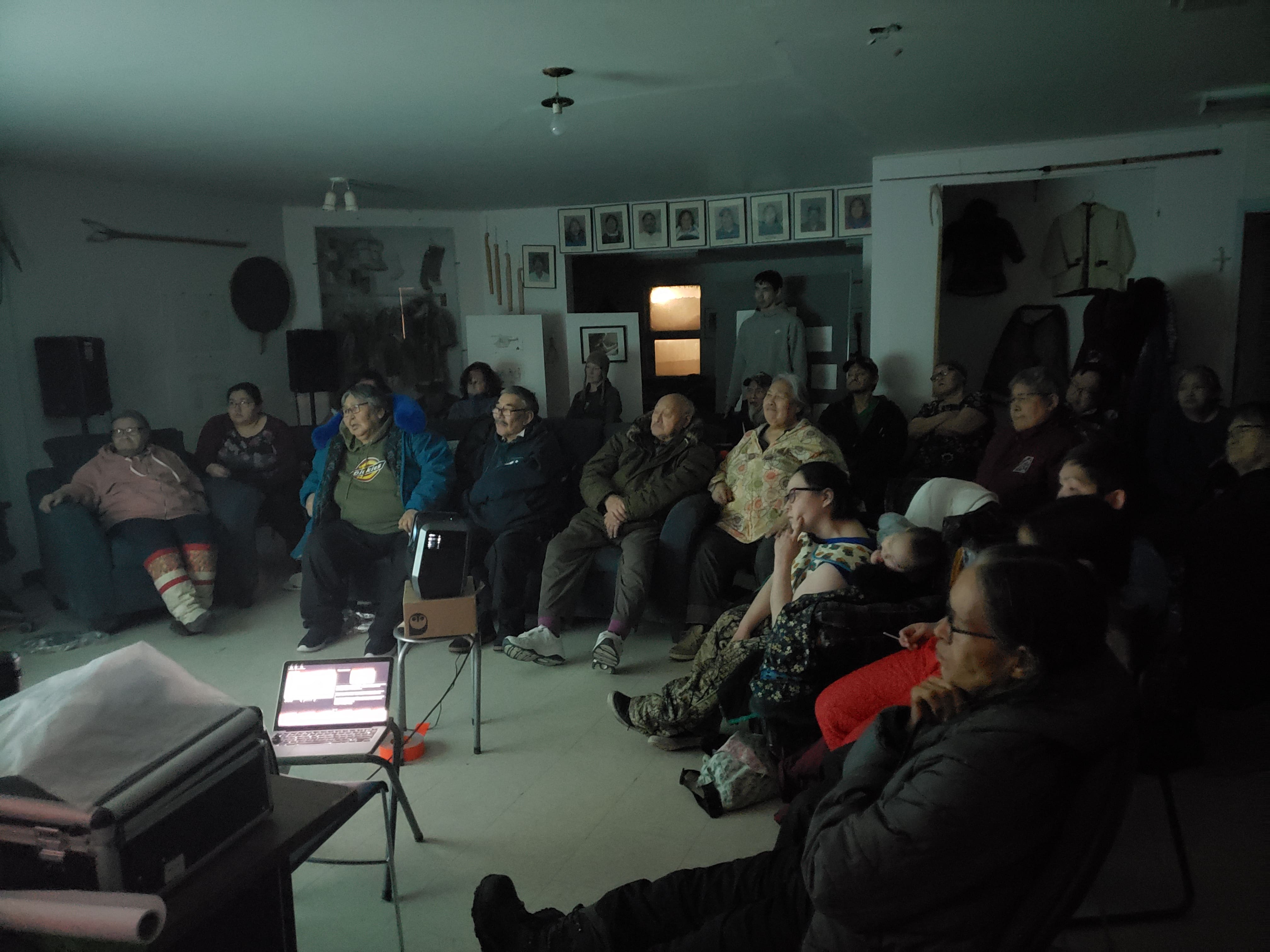
After the movies, it was time to eat.
As was explicitly put forward during the pre-workshop, food is a way to all find ourselves on common ground – we are all human. It's a way for people to feel comfortable. "Within the community we have human-to-human differences as well".Polar Bear Landscape Presentation[edit]
After the feast Marsha Brannigan, former wildlife biologist to the Northwest Territories presented on the governmental context within which the BearWatch project had played out.
This presentation was put on the agenda to sketch a contextual backdrop for the next couple of days. Although the presentation took 90 minutes, Branigan clearly had lots of experience with presenting for community members, and often built in "empty" slides, for people to ask questions or comments.
The opening evening ended with an invitation to come back the next days. We explained how the next three-day gathering was also part of the research project, and that people would be asked for their informed consent to be part of this research and to be photographed if they would come back over the next three days. We indicated our starting time, and explained the program for the next day: Science-presentations.
Day 1: Science-Presentations, Opening and Singing[edit]
The previous evening, around the time of closing prayers, news had started to trickle into the room about a young women that had passed away that day due to an accident. People had been visibly upset the evening before, and still were so when they came back the next day.
Elder Mary Aqilriaq, who was present to conduct the opening and closing prayers during this gathering requested to sing a song instead.
We all got up from our chairs as Mary led us into song. It was an emotional moment of shared grief and many people started crying in the room.
"Mary is gold. Even people here and there were telling me "I am so happy that Mary was here."
"Mary was perfect for us. It's really important that you pick the right person. There elders that are used to doing... being a master of ceremony, welcoming people, being the elder, you know. You used her. Her prayers are from the heart. Singing with her voice, even it is broken down. Giving it all she got. That's priceless. If you could get that. Sometimes, words... You don't have to talk, ey? (Tuppittia Qitualik)"
Introductions[edit]
Originally, this would have been the moment that the Gathering would be opened with some welcoming words by PI Peter van Coeverden de Groot, and HTA vice-chair James Qitsualik.
However it seemed clear that somewhat of a transition was required before "business as usual could be picked up.
As the designated host of the gathering, I stepped up to express my sympathies and reiterated that this gathering was meant to provide a space where we can meet each other as people, with emotions and identities beyond our titles and official functions.
I read out the general agreed upon guiding principles "to meet in a good way" that emerged from the pre-workshop, and then pointed out where people could find a poster with these principles in the room.
After that, I passed the word to Peter, who initiated an introduction round across the room.
Mx. Science Hosting[edit]
This introduction included all southern researchers, and all the community-members who had been working to set-up the space and support the gathering in various ways.
This included, for example, Aida Porter, who had agreed to be present on the first and third day to take plenary notes - a request that had emerged from the pre-workshop, as to keep track and collect questions that could not be answered during the gathering.
It also included a formal introduction "Mx. Science" to all the workshop attendees who had not met me yet.
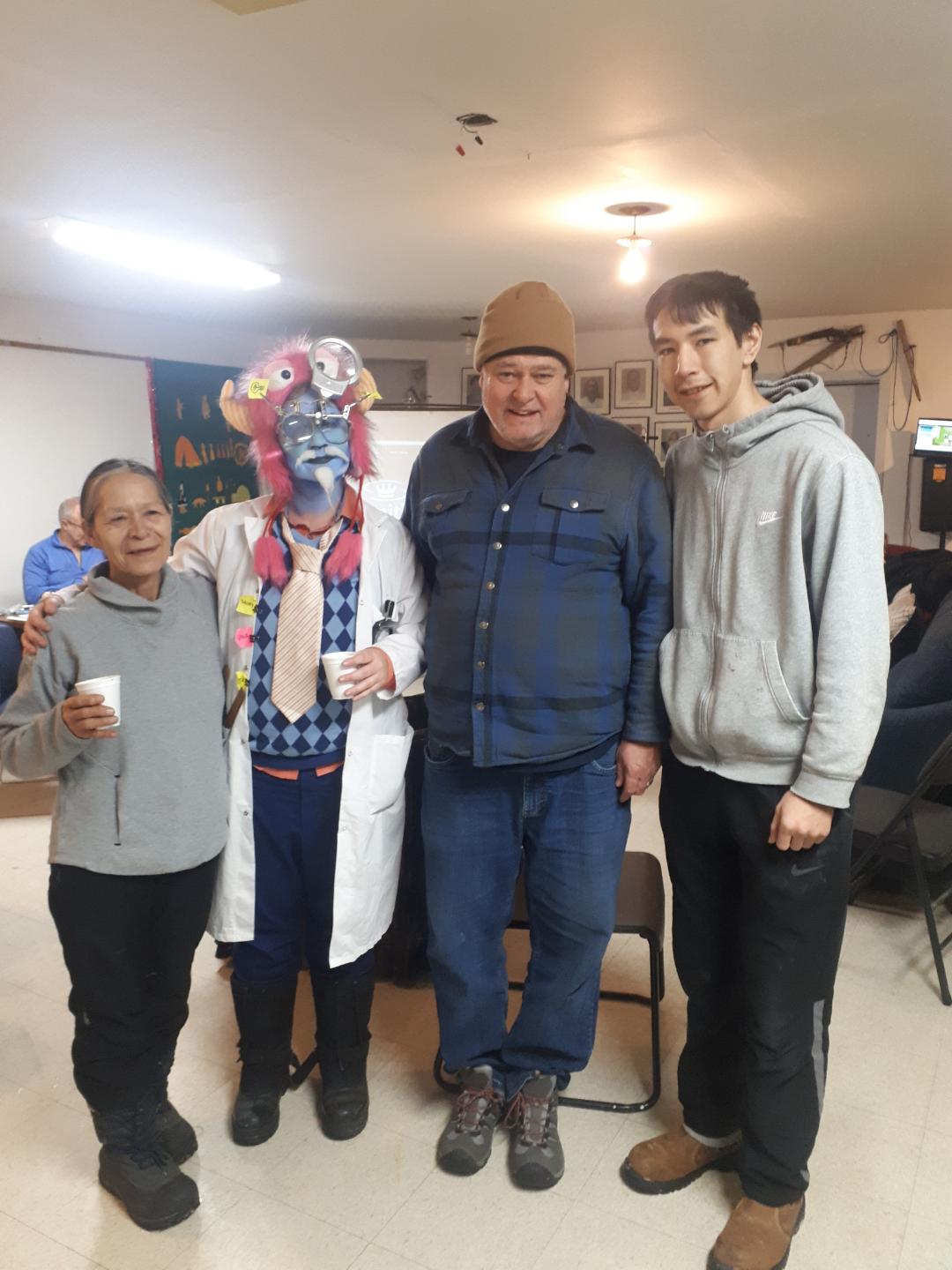
Although, I had not entirely anticipated taking the the role of a meeting moderator, it turned out to be expected from me - and I gladly stepped up, to do so.
Landmark: Gaps, Openings and Possibilities
Scientific Presentations[edit]
The first day of the Gathering was designed around presenting back to the community. Most of those were presentations were done remotely through the a starlink connection and zoom-presentation link.
Based on research I had conducted for a Research Assistance-ship on research communication, earlier in my PhD, I had asked presenters to use the "message box" (COMPASS, year) as a template to format their presentations with.
Preparing such a message box, can form a useful tool to "distil your knowledge in a way that resonates with your audience[1]."
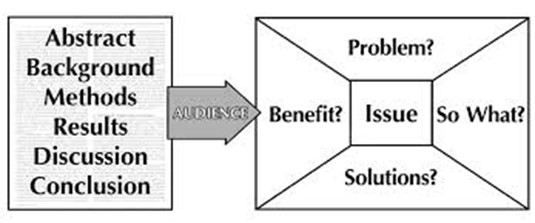
- ↑ Green, S. J., Grorud-Colvert, K., & Mannix, H. (2018). Uniting science and stories: perspectives on the value of storytelling for communicating science. Facets, 3(1), 164-173.
Exhibition Danny Aaluk[edit]
During the gathering I had installed an ongoing exhibition of Danny's work.
This exhibition was physically accessible, within the Gathering space, as well as digitally accessible through the Kumospace.
Art Gallery Danny Aaluk by gingertheworld
Day 2: Building Igloo[edit]
The second day of the workshop took a completely different shape.
Eight community members (three elders, four youth and the interpretor) joined with the eight participants from the south to build an igloo together.
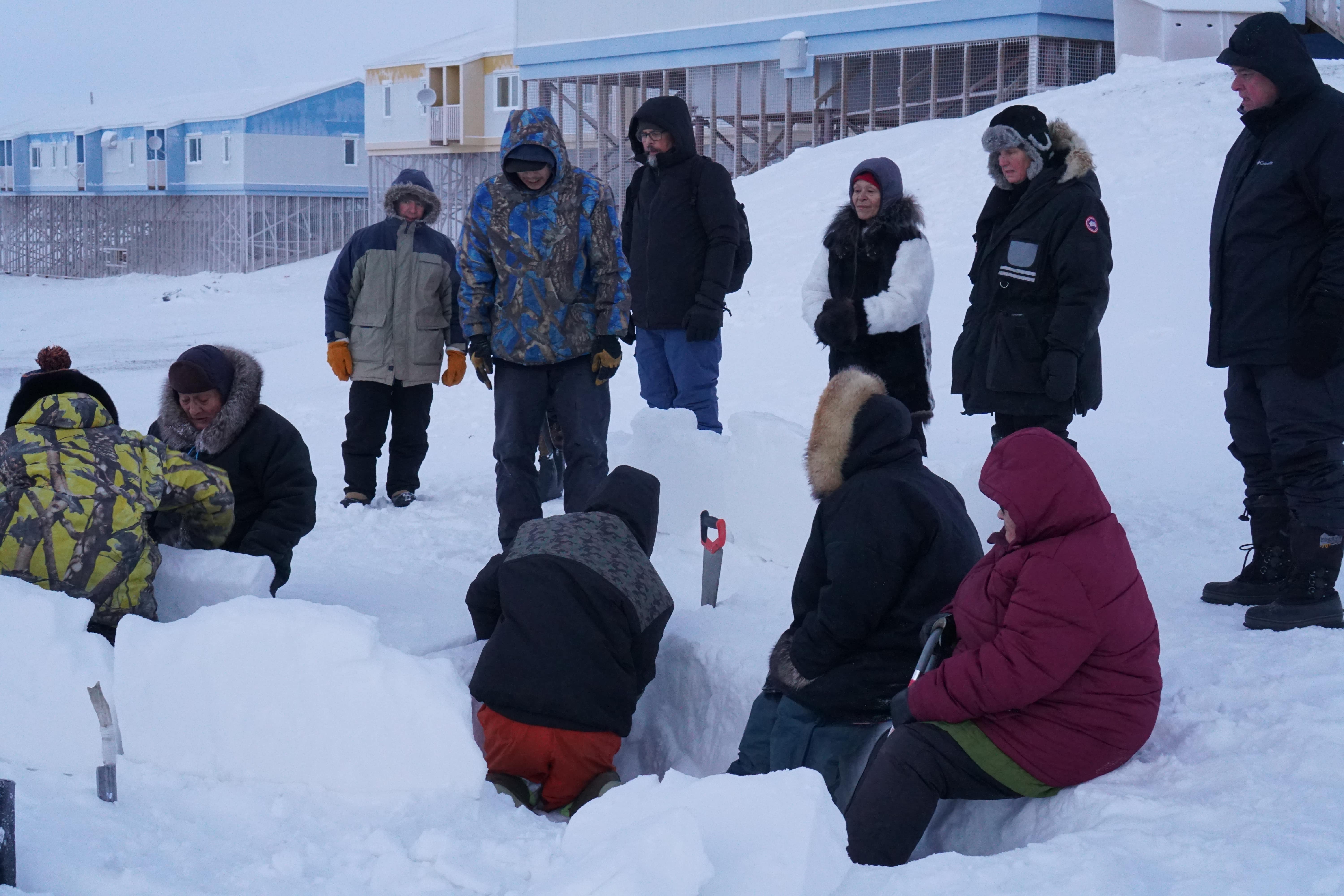
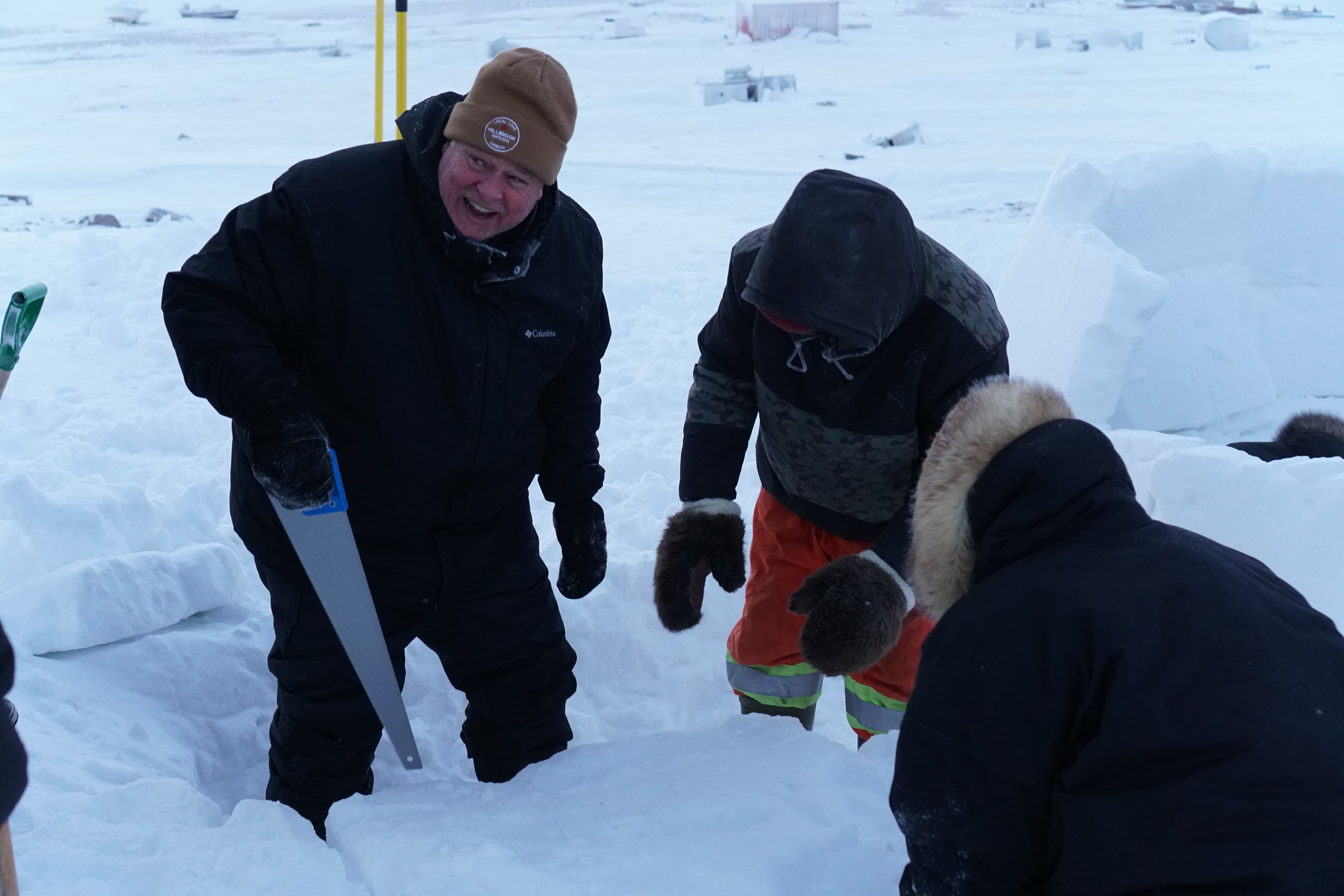
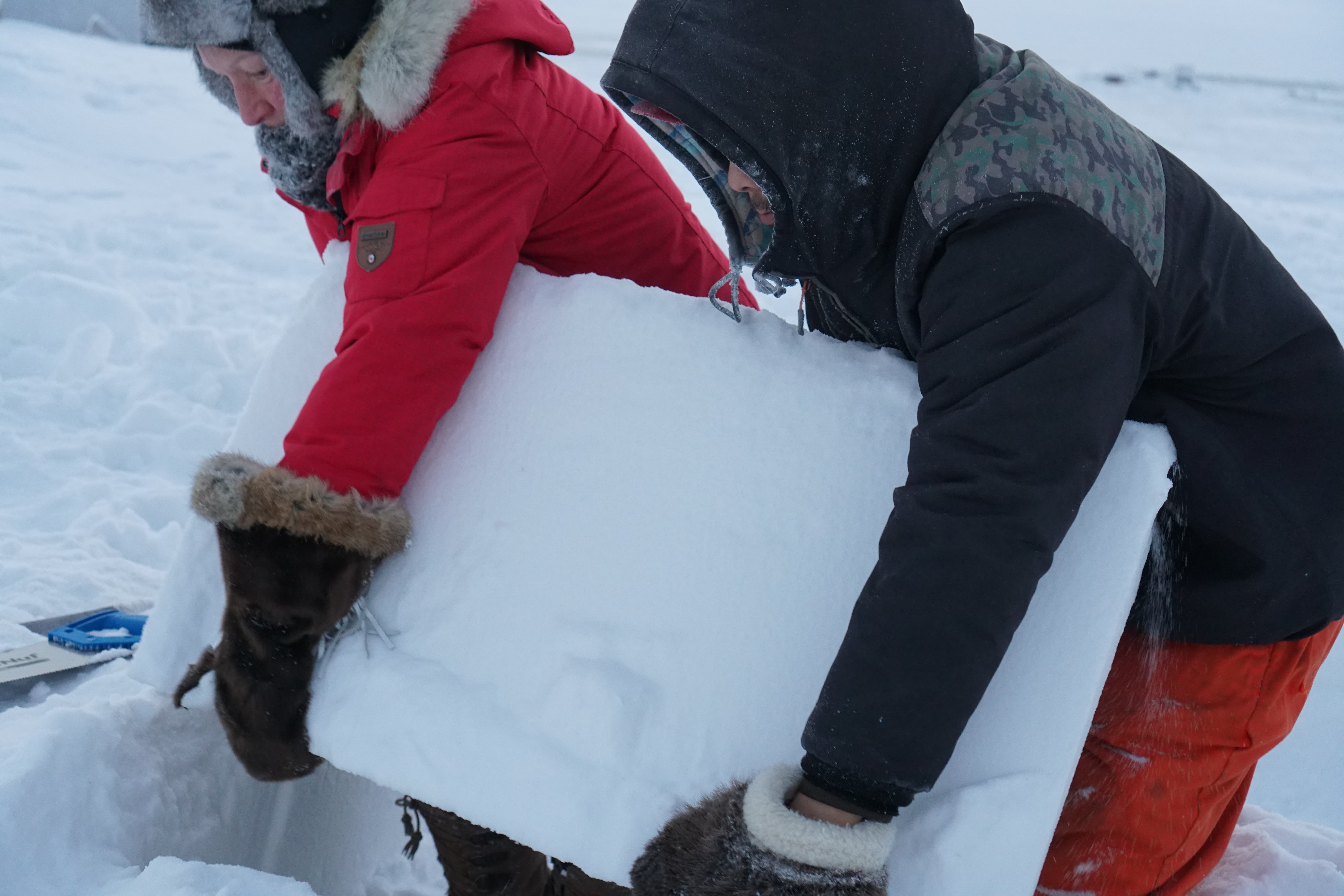
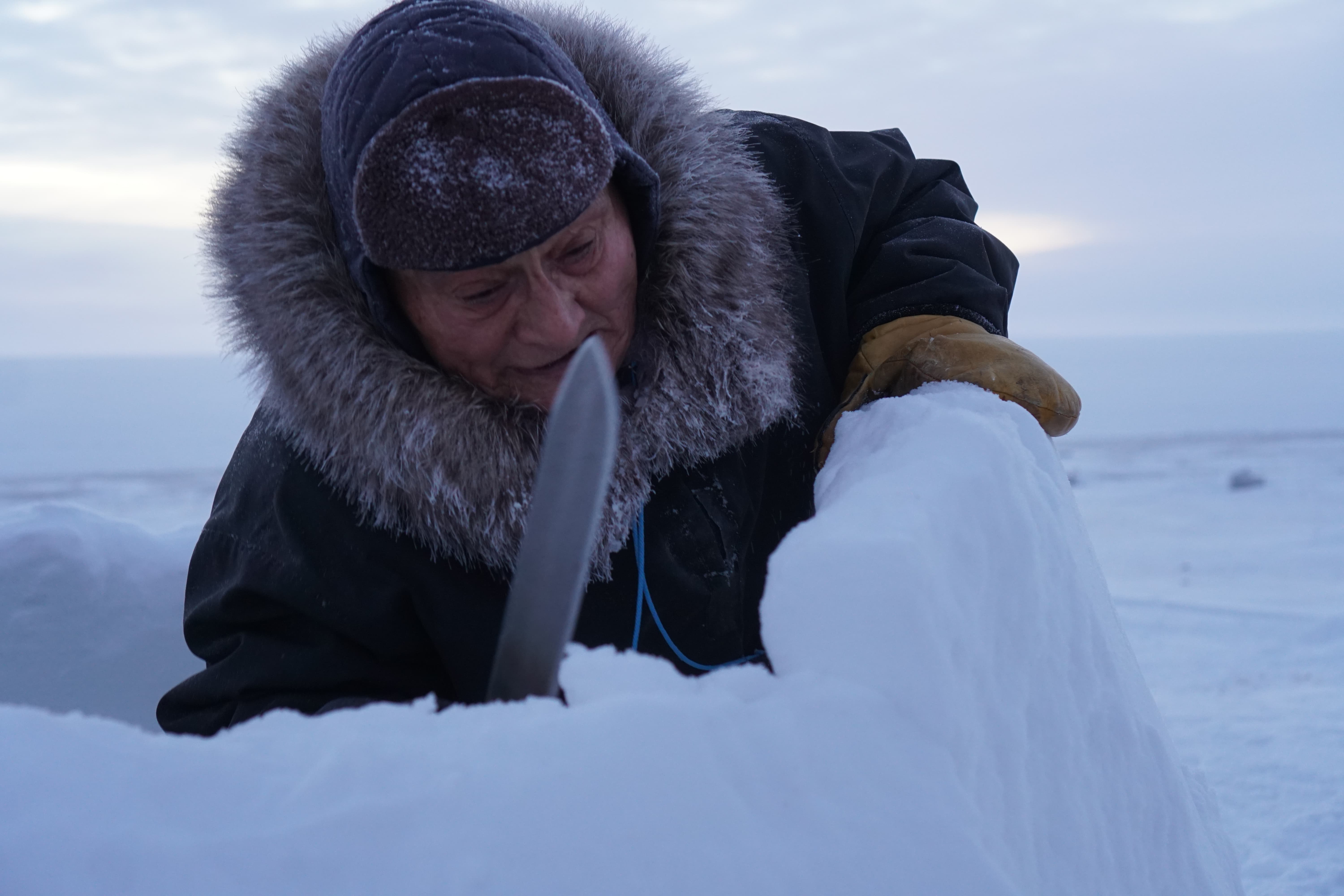
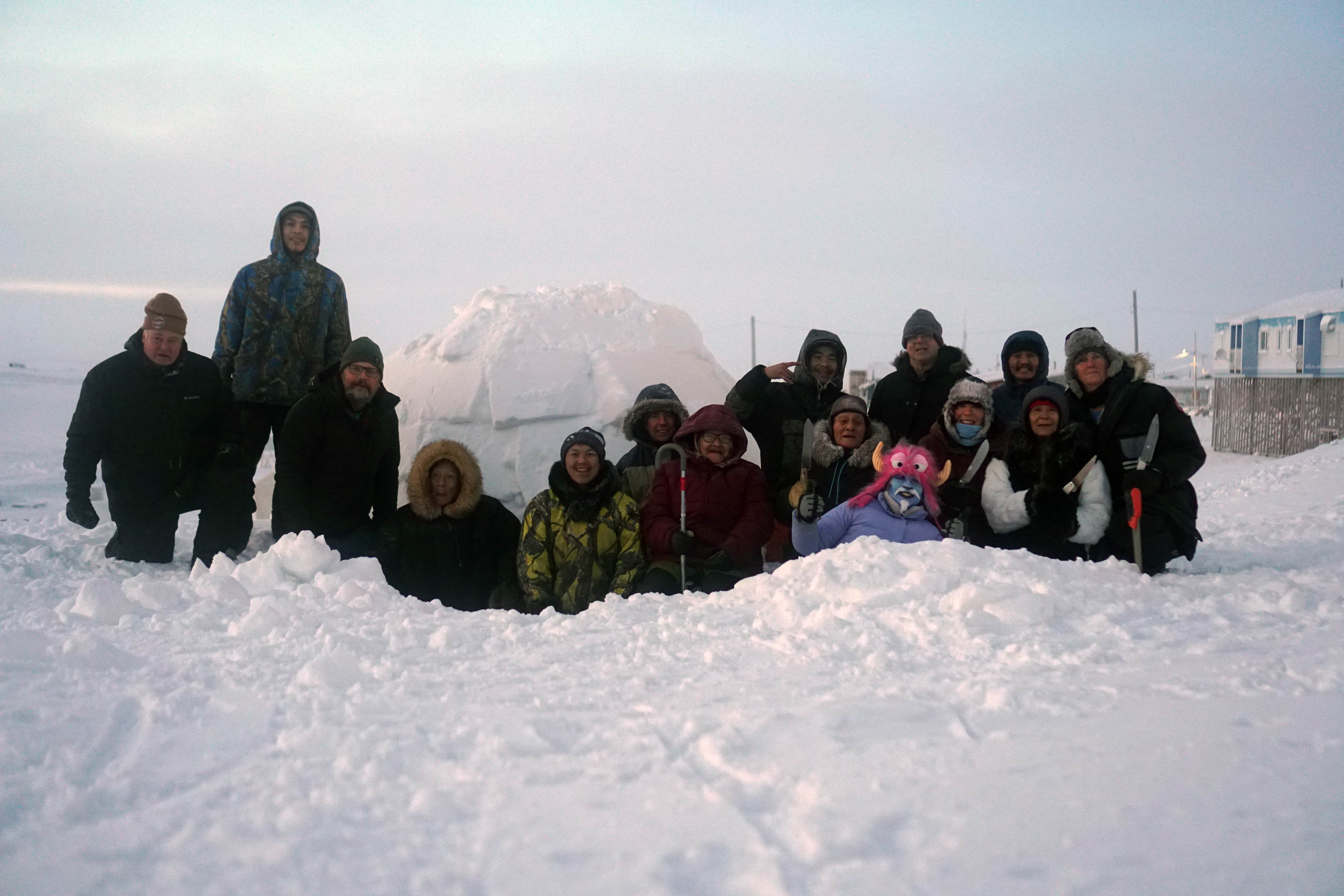
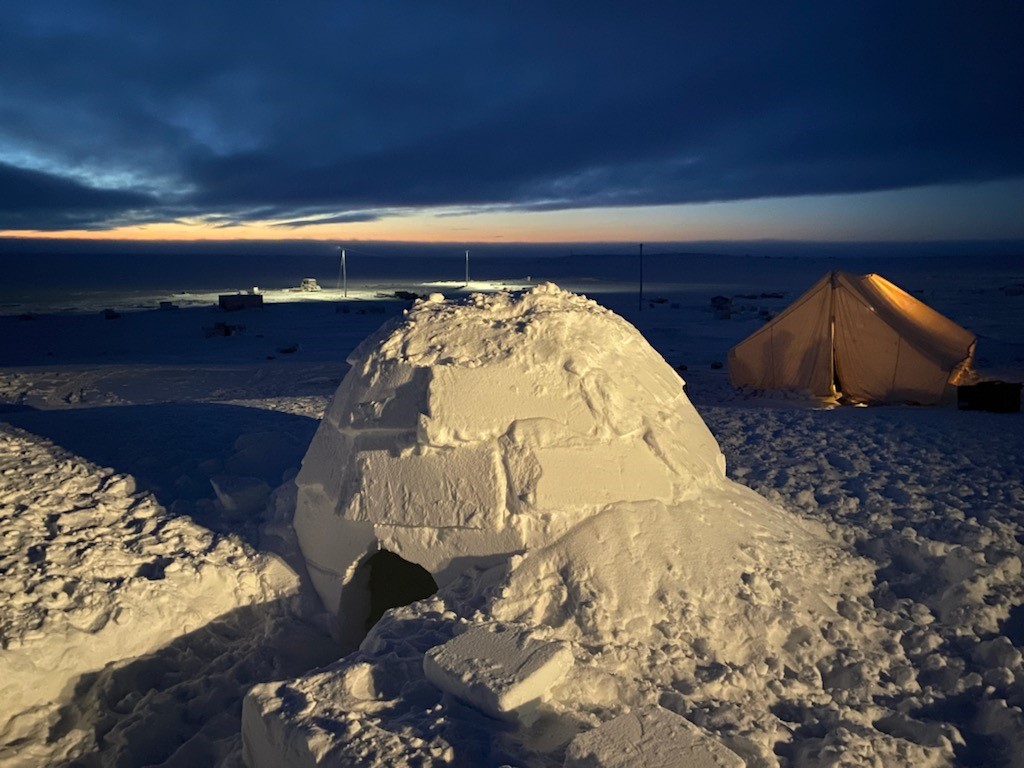
Community elders took the lead. And for the first hour, southern participants just observed.
As David and Jimmy discussed how to make the cuts and the outlines of where the igloo was to be built, they instructed the four young men that had joined to assist and learn, on what to do.
After a while, as agreed, two of the young men started to teach the southern researchers how to cut a block.
It became clear during the evaluation of the day that the elders had expected our blocks to all be "rejects". Our cuts were nevertheless clean enough for the blocks to be all used in the igloo.
Being able to build this structure together was considered by some southern participants as the highlight of the trip:
"(...) that's one of the, the most amazing days I've ever had (Prof. Whitelaw, 2022 post workshop interview)".
While others considered it an opportunity to appreciate inuit Qaujimajatuqangit in new ways:
“I realize Indigenous knowledge is also tied up with spirituality and, and, you know, different epistemologies and all that stuff, I get that, but what David and, and Jimmy demonstrated is, you know, evidence based cultural practices that the way that the snow comes together, the, kind of landscape where you're going to find that this is all based on, uh, experience. It's all based on, you know, many generations of experience and even, you know, the slant of the igloo walls when we started to construct it. And, all of that is, is evidence based in a way. And, and, you know, so sometimes people are dismissive of indigenous knowledge systems without appreciating that a portion of these knowledge systems are deeply empirical or deeply experience based. And that's just one of the things that struck me that. You know, that, that this reflects years and years of experience across generations to perfect this art form (PI prof. Lougheed, 2023 post workshop interview)."
Evaluation[edit]
After finishing the structure and taking a group picture, we retreated into a warm tent for Bannock and "klik". In the tent, we did one evaluative circle in which everyone got an opportunity to share how they had experienced the building of the igloo. As we went around the circle, everyone shared.

"I am so appreciative. I have the biggest thankfulness in my heart now because, especially big hats off to the people that organized these events. And then we had really good leadership in all their activities, especially in the building where you could see people are cooperating with each other. They're building relationships. And with our guests and with our community, we're making, we're, uh, making, uh, healing relationships with each other in that we are become, to know each other as humans and that we're treating each other with respect. And to share a meal and a good hot tea that, that kind of relationship building exercises. It was exactly what I needed and I really appreciates you have organized this (Elder Mary Aqilriaq)"
"I'm very proud to be here today, and I didn't expect the meal, the good meal, the tea, and all the laughter. This is the first time building an igloo. The knowledge that was passed down, I want to thank these elders too for being here, having to be here, having to lead (Percy Ikkuallaq)."
"(...) there's sort of this organic unfolding of an understanding between people. Um, and that's just beautiful to, uh, to, to observe and experience. And then we all come and kind of a little tentative first. And then, you know, we, we observe and we watch. And then confidence increases, and then we try to emulate. So it's sort of this connection, uh, between people is what I enjoyed most today. And I'm grateful for that (PI van Coeverden de Groot)".
Day 3: Living With Polar Bears[edit]
Day three of the gathering consisted of a panel-conversation on the future of polar bear monitoring and management. Its goal was to discuss how the tools that were developed through the BearWatch project could be implemented in future projects.
The idea of setting up a panel had also come from the pre-workshop. One of the questions I had asked during the pre-workshop was how we could ensure that there would be enough space for different voices to be heard, and in which ways we could make people feel comfortable enough to share. The suggestion was raised to erect a panel consisting of the following people: 2 senior researchers, 2 HTO people, 2 youth, 1 40/50 yr old, 2 elders.
Co-PI Peter van Coeverden de Groot moderated this third day.
Aida Porter, was unwell on this last day, so I took over her role as a note-taker by taking graphic notes (on-the-spot visualization).
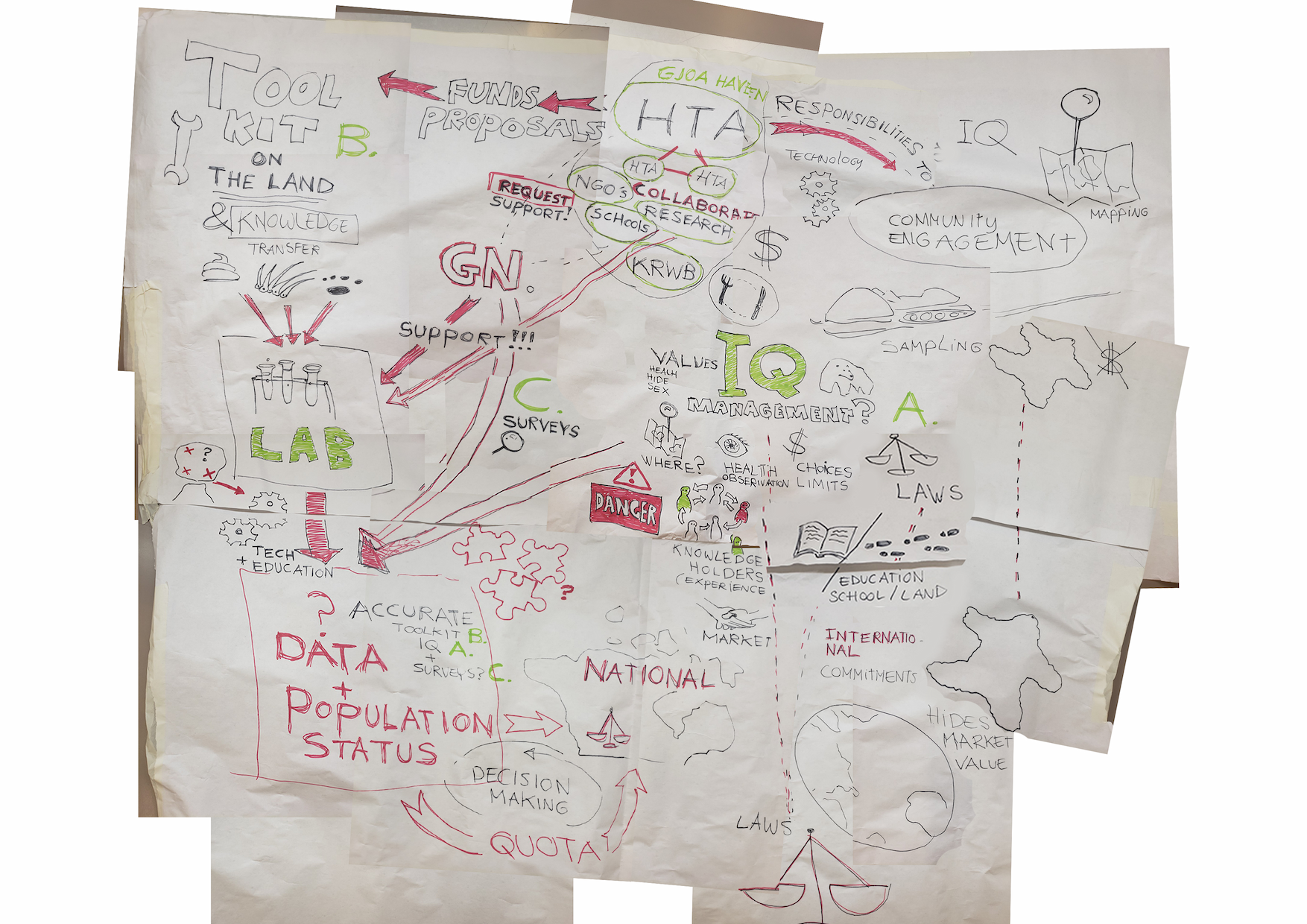
Closing[edit]
The morning after the third day we met with a small group to de-brief and evaluate the gathering.
Present at this evaluation were two elders that had joined the pre-workshop, the Gjoa Haven HTA vice-chair and our interpreter, as well as the BearWatch PI's, the former government biologist of NWT, and two BearWatch researchers including me. The funders had to leave earlier that morning.
There is little time to process the feedback that emerged in this evaluation right now. But it has been recorded.
"Keep going" and catch a charter plane to Coral Harbour, where a second workshop is planned.Design Consultation Pre-Workshop & Workshop Coral Harbour[edit]
This particular cut continues on a different track. The final workshop in Coral Harbour. The research in this community has emerged along completely different timelines and relational dynamics.
